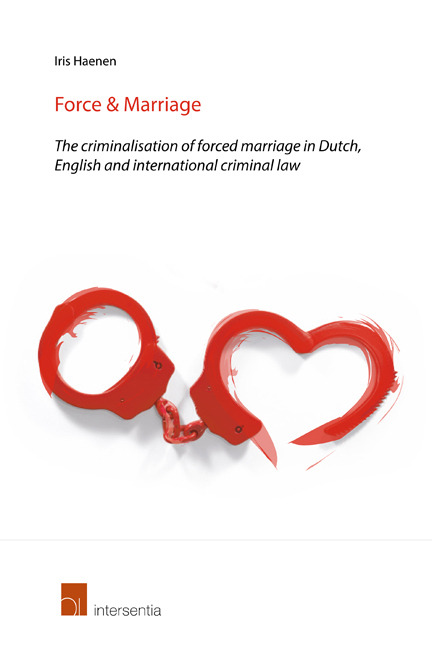 Force & Marriage
Force & Marriage Book contents
- Frontmatter
- Acknowledgements
- Contents
- Abbreviations
- General introduction
- PART I FORCE AND MARRIAGE: Description and definition of forced marriage
- Chapter 1 Consensus facit nuptias
- Chapter 2 Forced marriages in the Netherlands and England
- Chapter 3 Forced marriages in conflict situations
- PART II A TALE OF TWO THEORIES: Criminalisation on the level of national law and international law
- PART III THE LAW AND FORCED MARRIAGE: Legal frameworks concerning forced marriage in Dutch, English and international criminal law
- PART IV ANALYSIS AND CONCLUSIONS
- Summary
- Bibliography
- Table of cases
- Curriculum vitae
- Index
Chapter 1 - Consensus facit nuptias
from PART I - FORCE AND MARRIAGE: Description and definition of forced marriage
Published online by Cambridge University Press: 22 November 2017
- Frontmatter
- Acknowledgements
- Contents
- Abbreviations
- General introduction
- PART I FORCE AND MARRIAGE: Description and definition of forced marriage
- Chapter 1 Consensus facit nuptias
- Chapter 2 Forced marriages in the Netherlands and England
- Chapter 3 Forced marriages in conflict situations
- PART II A TALE OF TWO THEORIES: Criminalisation on the level of national law and international law
- PART III THE LAW AND FORCED MARRIAGE: Legal frameworks concerning forced marriage in Dutch, English and international criminal law
- PART IV ANALYSIS AND CONCLUSIONS
- Summary
- Bibliography
- Table of cases
- Curriculum vitae
- Index
Summary
INTRODUCTION
Before going into the issue of forced marriages in times of peace and conflict, it is important to first understand what ‘marriage’ and ‘force’ exactly entail. Only after taking careful cognisance of these concepts is it possible to start dissecting the phenomenon of forced marriage. To this end, this chapter provides the book's conceptual framework. First, the concept of marriage is elucidated and with the help of sociological definitions, a universally applicable definition of marriage is formulated (paragraph 2). In paragraph 3, several universal and regional human rights instruments are analysed. As a direct consequence of the Nazi racial laws prohibiting mixed marriages between certain ethnic groups and the injustices committed under the veil of marriage during the Second World War – such as child marriages and marriage as a cover for slavery – the international community saw fit to formulate marriage as a human right. By including the right to marry in the 1948 Universal Declaration of Human Rights (UDHR), the international community gave expression to the importance of this institution and its central position in society. An entire gamut of international human rights treaties now contain provisions on the right to marry and on the equality between men and women during every stage of the marriage. After discussing these instruments, the concepts of coercion and consent are explored. Finally, in paragraph 4, a working definition of forced marriage is presented; if necessary, this working definition will be revised after the description and discussion of the practice of forced marriage as it takes place in times of peace and conflict (Chapters 2 and 3). A separate sub-paragraph is devoted to the practice of arranged marriages. Paragraph 5 contains some concluding remarks.
MARRIAGE
THE SOCIOLOGY OF MARRIAGE
Marriage as a way of organising life and formalising relationships has existed as a social institution in all societies throughout history. Throughout recorded history, marriage has been the main vehicle by which (private) property was exchanged and handed down to new generations, and by which sexual relationships and the position of children in society were regulated.
- Type
- Chapter
- Information
- Force & MarriageThe criminalisation of forced marriage in Dutch, English and international criminal law, pp. 13 - 46Publisher: IntersentiaPrint publication year: 2014


